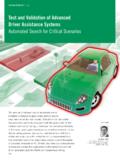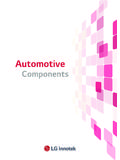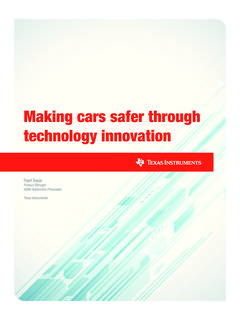Transcription of Beyond The Headlights: ADAS and Autonomous …
1 Beyond The Headlights: adas and Autonomous SensingSeptember 2016 Source: Texas Instruments, WCPW oodside Capital PartnersTel: +1 650 513 2775 ViewSurround ViewBlindSpotDetectionParkAssistParkAssi stAdaptiveCruise ControlEmergency BrakingPedestrian DetectionCollision AvoidancePark assistance /Surround ViewRearCollisionWarningCrossTrafficAler tTraffic SignRecognitionLane DepartureWarningLong-Range RadarLIDARC ameraShort/Med-Range RadarUltrasoundEye/Face TrackingEXECUTIVE Global Road Crash DOT Guidelines For Autonomous adas to to Autonomous Sensing Systems Market from the adas Semiconductor Systems for to Sensing Systems for LiDAR Radar Based Company Contact and Important DisclosuresTable of ContentsIntroduction Sensing systems are the most important enablers for adding intelligence in the automotive world With advanced Driving assistance Systems ( adas ) becoming common in high end cars, multiple cameras being used on cars is becoming standard.
2 Most of the concerns regarding safety, such as blind spot warnings, forward collision warning, and avoidance, have been diminished because of the use of cameras and advancements in machine vision technologies With the aim of making cars safer to drive, new features are being added to the driving assist systems. Most of these systems are enabled bysensingtechnologies. To overcome the limitations of traditional cameras, new sensors such as Radar, LiDAR and ultra sonic are also being used to enhance the features for adas There is also considerable traction in the Autonomous driving area as most car companies, along with companies such as Google, are spending time and resources on the automotive research. Here, sensing systems play the key enabler role, as creating an accurate perception of the surrounding environment is an important parameter for such systems Sensing systems are also used for in-car monitoring, driving analysis, and car security, adding additional safety features to automobiles.
3 A brief overview of sensing systems and their applications is given in the following slides3 Annual Global Road Crash Statistics Nearly million people die in road crashes each year, on average 3,287 deaths a day; an additional 20-50 million are injured or disabled More than half of all road traffic deaths occur among adults ages 15-44 Road traffic crashes rank as the 9th leading cause of death, and account for of all deaths globally Road crashes are the leading cause of death among young people ages 15-29, and the second leadingcause of death worldwide among young people ages 5-14 Each year nearly 400,000 people under 25 die on the world's roads, on average over 1,000 a day Over 90% of all road fatalities occur in low and middle-income countries, which have less than half of theworld's vehicles Road crashes cost USD $518 billion globally, costing individual countries approximately 1-2% of theirannual GDP Road crashes cost low and middle-income countries USD $65 billion annually, exceeding the totalamount received in developmental assistance Unless action is taken, road traffic injuries are predicted to become the fifth leading cause of death by2030 Source.
4 Association For Safe International Road Travel (ASIRT) 20164US DOT Guidelines For Autonomous Vehicles5 How and where the car is supposed to operate How the car detects and responds to oncoming objects How the system responds in case of a software failure How it was tested and validated How it protects user data How it records and shares data How it is programmed to address ethical dilemmas on the roadThe US Department of Transportation released itsFederal Automated Vehicle Policy in September 2016, comprised of four parts: vehicle performance guidance (a 15-point safety assessment); model state policy (delineating federal and state roles); current regulatory tools; and modern regulatory rules meant to address the following topics:GENERAL adas OVERVIEWI ntroduction to adas advanced driver assistance systems ( adas ) are systems developed to automate/adapt/enhance vehicle systems for safety and better driving. Safety features are designed to avoid collisions and accidents by offering technologies that alert the driver to potential problems, or to avoid collisions by implementing safeguards and taking over control of the vehicle.
5 Adaptive features may automate lighting, provide cruise control, automate braking, incorporate GPS/ traffic warnings, connect to smartphones, alert driver to other cars or dangers, keep the driver in the correct lane, or show what is in blind spots adas relies on inputs from multiple data sources, including automotive imaging, LiDAR, Radar, image processing, computer vision, and in-car networking. Additional inputs are possible from other sources separate from the primary vehicle platform, such as other vehicles, referred to as Vehicle-to-Vehicle (V2V), or Vehicle-to-Infrastructure (such as mobile telephony or wifidata network) systems adas is one of the fastest-growing segments in automotive electronics, with steadily increasing rates of adoption of industry-wide quality standards, functional safety in accordance with ISO 26262, and developing technology-specific standards, such as IEEE 2020 for Image Sensor quality and communications protocols and standardized computer systems such as the Vehicle Information API and on-board diagnostics (OBD) codes Among the anticipated benefits of Autonomous cars is the potential reduction in traffic collisions (and resulting deaths, injuries, and costs)
6 Caused by human-driver errors, such as delayed reaction time, tailgating, rubbernecking, and other forms of distracted or aggressive driving78 adas MarketGlobal adas MarketGlobal adas by system TypeGlobal adas by Sensor TypeGlobal adas by Geography Global advanced Driver assistance Systems Market is expected to reach $ Billion by 2020 Growing at a CAGR of (2014-2020)02040608020132014201520162017 201820192020$Bn The comprehensive view on the % share of system type segment The comprehensive view on the % share of market by sensor type (2020)LASER SensorLiDAR SensorImage SensorRadar SensorInfrared (IR) SensorUltrasonic SensorAdaptive Front Lighting SystemLane Departure Warning SystemBlind Spot Detection SystemAdaptive Cruise Control SystemPark Assist SystemDrowsiness Monitor SystemTire Pressure Monitoring SystemLAMEAAPACE uropeNorth AmericaSource: Allied Market Research, 2015 The comprehensive view on the % penetration of adas Technology by geographical location. Europe leads the way with just over 60%The Road to Autonomous Driving Safety Evolves Towards Automated and Autonomous Driving9 Source: Infineon, 2015 adas to Fully Autonomous : Steps Toward Automated Drive10 Safety and Convenience Will Drive the Embrace of Computer-Aided Driving SAE Level of Driving Automation2000 2010 2020 2030 SAE Level 5:Full AutomationProducts:Driver Controls EliminatedSensingSystems:3D LiDAR sensorsSAE Level 4:High AutomationProducts:Highway Driving, Stop & Go (City) DrivingSensingSystems:Short/Med Range RadarSAE Level 3:Conditional AutomationProducts:Hwy Asst, Autonomous Parking, Stop & Go (Hwy)SensingSystems:Ultrasound RadarSAE Level 2:Partial AutomationProducts:Automated Parking Asst, Lane Departure WarnSensing Systems:Camera, Short Range Radar SAE Level 1:Driver AssistProducts:Adaptive Cruise Control, BlindspotWarn, LDWS ensingSystems.
7 Long Range Radar, CameraSystem ControlHuman DrivingSource: Woodside Capital, 2016 Automotive Sensing Systems - Market MapSensing SystemsOutwardInwardCameraSoftwareandSys temsOEMsTier 1 sAutonomousProcessorsSensorsLiDAR SystemsRadar SystemsIR LED 1-2 umLaser Scanner 1ummmWave11 Cost of Various Elements in Autonomous Driving12 Source: Boston Consulting Group, 2015 Notes From The adas Semiconductor Market13 Adoption of adas has been accelerated by the active development of Autonomous cars by Google, Apple and Uber The adas Semiconductor market is expected to grow $ in 2015 to $5B in 2025 according to McKinsey Processors: ECU and MCU are key parts for adas applications. Low power, high frequency multi-core architectures are required. In addition to traditional automotive semiconductor suppliers, Intel, Qualcomm, and NVIDIA have joined the market adas will need to support many algorithms for different functions Software updates must be downloaded (refer to Tesla /Chrysler hacking event July, 2015) Sensors: very critical parts will include visual imaging devices, RF/Radar devices, and ultrasonic In Vision-based adas , Mobileye takes a lead with a few companies providing Driver-monitoring systems based on software such as Seeing Machines Mobileye s shipped an estimated 5M units in 2015 Infineon shipped 10M units of 77 GHz Radar chips in 6 years (Major customer.)
8 Bosch) Infineon also expects 10M new cars to deploy 77 GHz Radar in 2016 Freescale partners with Continental to promote 77 GHz Toyota started deployment of Safety Sense in model year 2015 Denso deploys 77 GHz Radar + Camera It looks like Radar and Vision will co-exist Freescale acquired CogniVue Infineon partnered with PMD and Kostal ST partnered with Mobileye LiDAR systems use high-end laser scanning systems to generate complete 3D image of the environment. It is expensive at $8,000. Now, Solid State LiDAR systems have gone to the market from Quanergyand LedderTech. They use solid state Laser or near IR optical devices to reduce cost significantly Systems requirements will put semiconductor companies in much closer contact with OEMs Autonomous cars will require more connectivity (V2X and Cloud); Security is a very critical issueSemiconductor Revenue by adas Application14 Source: McKinsey, Feb, 2016 Semiconductor Revenue by adas ApplicationSemiconductor Revenue by adas DeviceCPU36%Optical devices28%RF13%Memory12%Mixed Signal8%Other3%2025$ ~$ $ - $ $ - $ otherNight VisionAdaptive Front LightsDriver Monitoring SystemBlind Spot DetectionLane Departure WarningAutomatic Emergency Braking, AdaptiveCruise Control, Forward Collision WarningParking assistSENSING SYSTEMS FOR ADAS16 Sensing Systems for adas Sensing systems for perception of the environment are the major enablers of advanced Driving assistance Systems ( adas )
9 And Autonomous driving adas provides features like forward collision avoidance, lane departure warnings, pedestrian detection, parking assistance and adaptive cruise control Many adas systems have a forward camera-based system offering most of the above features effectively, with a rear camera for parking assistance . Mobileye has emerged as a major player in this segment with its EyeQseries of system on Chips (SoC) However, camera-based systems have limitations in terms of range, and do not provide depth while operating only in visible light conditions. These systems become less reliable as visibility is challenged due to environmental factors such as fog, snow, and in the dark of night The depth, sensing problem is often solved using stereo camera systems instead of monocular systems. These systems are used to provide a 360 degree view For advanced adas , providing semi- Autonomous driving capabilities using advanced cruise control, additional sensors are included LiDAR, Radar, ultrasound sensors, etc.
10 This adds additional information like 3D depth-sensing, wider vision angles, and larger range, making it operational at much greater speeds and providing advanced calibrated control capabilities rather than just stopping or indicating danger Apart from these perceptive vision, sensing elements There is also a need for advanced sensor fusion algorithms and control systems to deliver on the adaptive cruise control features Major players providing such features include: Bosch, Continental, Magna, Autoliv, Delphi, Denso amongst Tier 1 suppliers while most major automotive OEMs have developed their own systems in collaboration with the Tier 1s including General Motors, Ford, BMW, Daimler, Toyota, Volkswagen group, Volvo, Hyundai, Nissan and others17 Sensing Systems for Autonomous Driving Level4 andlevel5 autonomousdrivingrequirea completereal-time3D viewofsurroundingswithperceptiveinformat ionincludingdistinguishingobjectsandaccu ratedepthinformation Mostofthevisionsensorsusedarethesameasin adas asseeninthefigureonpreviousslide.






